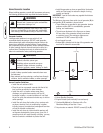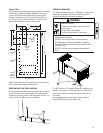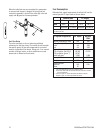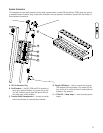
12 BRIGGSandSTRATTON.COM
When the initial test runs are completed, the manometer
is removed and the port is plugged. A typical final fuel
connection assembly is shown here, where (A) is the fuel
supply and (B) goes to the home generator.
Fuel Pipe Sizing
There are numerous on-line or otherwise-published
references for fuel pipe sizing. The installer should consider
the specific gravity of gas and compensate for a nominal
amount of restriction from bends, fittings, etc. If an unusual
number of fittings, bends, or other restrictions are used,
please refer to federal and local codes.
Fuel Consumption
Estimated fuel supply requirements at half and full load for
natural gas and LP vapor fuels are shown below.
B
A
Natural Gas LP Vapor
1/2 Load Full Load 1/2 Load Full Load
45kW 483 C 777 C 178 C 297 C
483,000 B 777,000 B 445,000 B 742,000 B
C = Cubic feet per hour
B = BTU’s per hour
Physical Properties LP Vapor Natural
Gas
Normal Atmospheric State Gas Gas
Boiling Point (in °F):
Initial
End
-44
-44
-259
-259
Heating Value:
BTU per gallon (Net LHV*)
BTU per gallon (gross**)
Cubic feet (gas)
83,340
91,547
2,500
63,310
1,000
Density*** 36.39 57.75
Weight† 4.24 2.65
Octane Number:
Research
Motor
110+
97
110+
* LHV (Low Heat Value) is the more realistic rating.
** Gross heat value does not consider heat lost in the form of water
during combustion.
*** Density is given in “Cubic Feet of Gas per Gallon of Liquid”.
† Weight is given in “Pounds per Gallon of Liquid”.


















